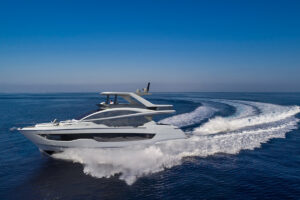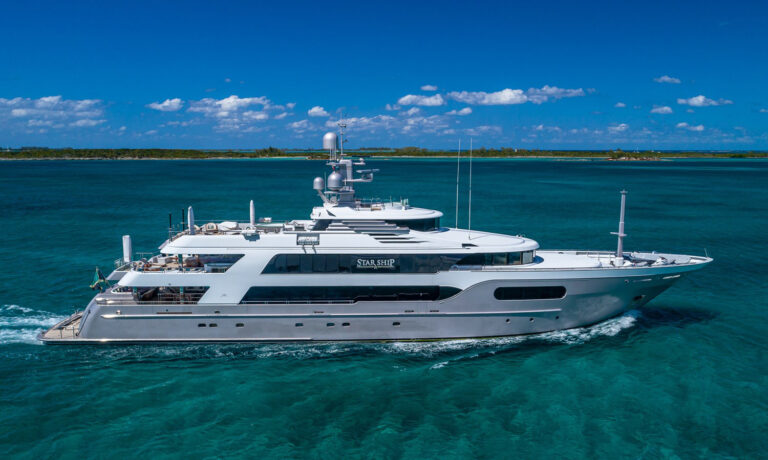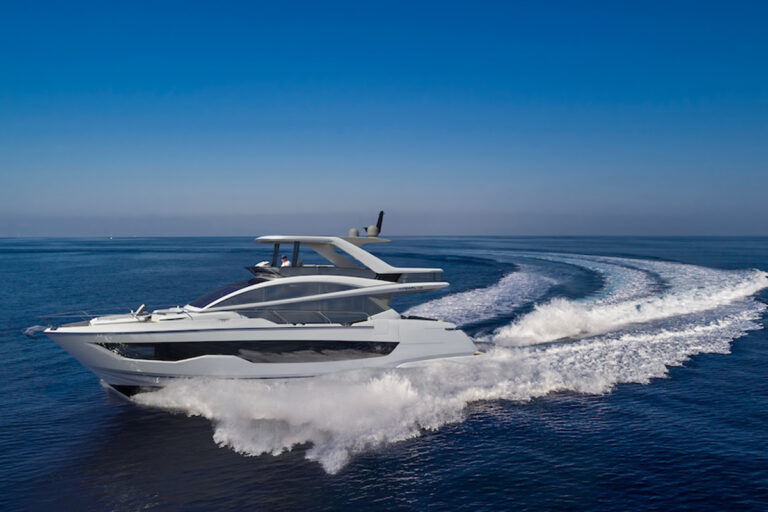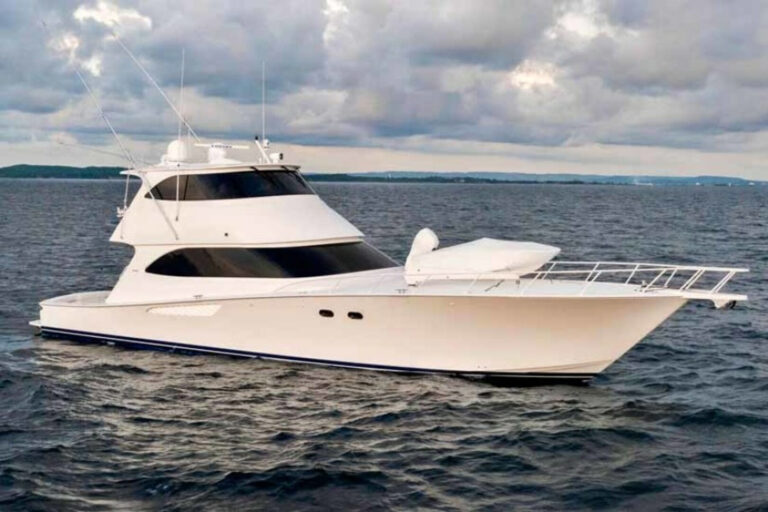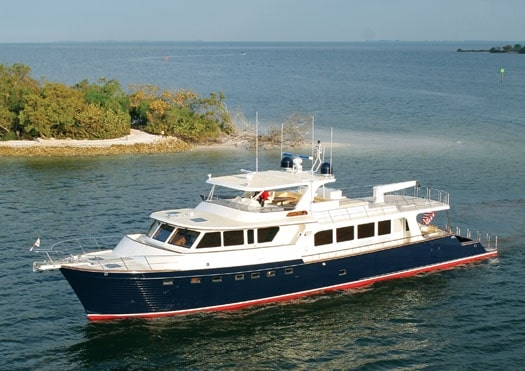
Marlow 86 CMY
A boat test with David Marlow is like a visit with your favorite grandfather. You know there are going to be some great stories and lots of laughter, and you can usually expect a couple of surprises as well.
So it was that I found myself struggling to stay with David as his long legs strode across his shipyard on Florida’s Snead Island. “You’ve gotta see this,” he hurled over his shoulder as I huffed to keep up with him in the hot sun. “It’s gonna blow you away!”
“It,” I assumed, was the new Marlow Explorer 86 Cockpit Motor Yacht, the latest and largest iteration of the very successful line of Marlow cruising yachts. Marlow, of course, is no Johnny-come-lately to boatbuilding. Legend has it, David Marlow had originally planned to build only one boat-for himself-but then everyone else wanted one, too. Marlow has done it all: he’s cruised, he’s raced, he’s built boats, he’s been a shrimper, and he’s probably wrung more salt water out of his socks than most builders have ever seen.
As we drew closer to the yacht, I was reminded that, unlike some builders who want to design as tall as they can on a given length, Marlow has always gone with low profiles that are pretty. The 86 is no exception. The lines of the house mirror the sweetly curving sheer line, the windows are neither too large nor too small, and even with a hardtop or a fully enclosed bridge, she’ll never be a “floating condo.”
We cast off our lines and backed away from the dock, using the thrusters to carefully center ourselves in the channel because it was-to use a technical weather term-blowing dogs off their chains. With this much wind, the water in the bay near Snead Island was pushed out to sea, leaving only inches under the hull. That isn’t a problem with a Marlow, though, because the props and rudders are well protected by a full-length keel and husky skegs.
Once offshore, the first part of Marlow’s “surprise” was summed up neatly: “This is a haul-ass boat.” True enough. Running beam-on to the wind, we topped 31 knots on the GPS without breathing hard. And we also reached that 31 knots from idle in about 25 seconds, which is a lot better than my first Volkswagen could do.
But the essence of Marlow’s “surprise” was at the complete opposite end of the performance curve. Pointing the bow into a breeze that was a steady 25 and gusting to 30, Marlow brought one engine back to 750 rpm and dropped the other into neutral. The speed scuffed off as the GPS settled on 7.9 knots.
“Now, look at this,” David said, tapping the Caterpillar engine monitor. The pale numerals showed 4.6 gph on fuel consumption. Yipes! Here was the real surprise! Running on one engine at just shy of 8 knots while pushing 65 tons through the water and wind, we were getting about 1.7 miles per gallon! With the standard 4,000 gallons of fuel, the Marlow 86 would have a range of about 6,000 nautical miles even if you left a 500-gallon safety margin.
Those were intriguing numbers and, that evening, I cracked my navigation texts to pinpoint exactly what this kind of cruising range meant. I discovered you could, for example, cruise nonstop from Miami to Gibraltar with about 1,800 gallons of fuel left in the tanks for exploring the Mediterranean. Or you could go from San Diego to Papeete on about half a tank. If your pulse doesn’t start pounding at the thought of seeing the motus of the Marquesas or the Riviera’s Promenade des Anglais on the horizon with just a twist of the ignition key, well, have your blood pressure checked.
Of course, any 86-footer with 4,000 gallons of fuel is going to have longer legs than a similarly sized marina-hopper that isn’t intended for offshore exploring. More fuel automatically means more range. And a devil’s advocate might say that you can do this with any twin engine yacht: Just install big fuel tanks and travel with one engine shut down.
Au contraire. Every skipper with a few miles under his sea boots has likely had the misfortune of losing an engine, only to spend hours wrestling the boat back to harbor on a single screw. It’s not much fun.
Yet on one engine, the Marlow 86 tracked like the monorail at Disneyland. Believe me, I gave it my best shot: upwind, downwind, crosswind-and this wasn’t a pretty-day, flat-water test-we had a solid 25 knots of breeze trying to push us around. It didn’t handle as well as it would with twin screws, but it also didn’t worry the autopilot into a pile of smoking rubble.
It’s clear that the Marlow 86 benefits from several clever design features. First, David Marlow has created a very slippery hull that is happy at a range of speeds.
Second, the long keel and the proprietary Marlow Strut Keels, which encase and protect the props and rudders, give the 86 a directional stability that resists wind and sea. And, as mentioned before, the keel and struts also allow the 86 to sit upright at low tide without damage to the running gear. The prop pockets are also a new design, and permit 46-inch props with only about 10 percent clearance, while still avoiding prop tip-burning.
Resin infusion has become a catch phrase in boatbuilding, and there’s no question that this method of construction has real advantages over traditional hand layups. Though it’s a complicated process, builders like it because there’s less waste. It’s also quicker because it doesn’t require much finishing when the part comes out of the mold: grinding and painting are reduced to a minimum. From a buyer’s standpoint, resin infusion is desirable because it creates a matrix that is both stronger and lighter. And, of course, if the builder can save on materials and time, those savings are passed along to the buyer. It’s win-win for everyone.
But because resin infusion is a new process, it’s created an arena where any builder with a pump and a vacuum bag can make wild claims. In short, there is resin infusion and then there is resin infusion. David Marlow has patented a process called Resin Infusion Vacuum Assisted Transfer (RIVAT) that allows what he calls “full stack” infusion for an entire hull. In this process, the vacuum-assisted infusion of resin penetrates as many as a dozen layers of laminates and coring and finally the Kevlar inner skin.
The beauty of RIVAT is not just that it completely eliminates any voids in the hull, but also prevents contamination from airborne particles that can weaken the laminate.
The first Marlow 86 CMY went to the previous owner of a Marlow 78 with a big extended family. So the 86’s salon was arranged for entertaining, with a 52-inch flat-screen TV and an oversized dining area. A thoughtful touch is the day-head that opens to the California deck.
Filling the forward portion of the deckhouse is a well-equipped galley and the helm, with a centerline seat and a wraparound dinette/lounge for guests.
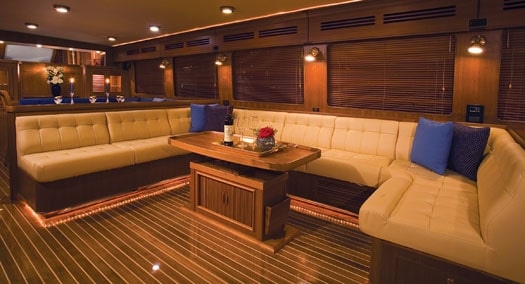
| | |
Accommodations are for ten guests in four staterooms, and the arrangement is unusual. The forward VIP cabin has a king-sized centerline berth, plus-get this-a pair of pilot berths above and outboard of the main berth. The thinking is that this would be a great cabin for a kids’ pajama party and, if they want to play music or giggle into the wee hours, they’re well separated from the adults. Or you could put three fishing buddies in here, too. When they’re not needed for sleeping, those pilot berths make a great place to stash all the clothes and gear that can clutter up a cabin on a cruise.
The master suite spans the full beam amidships with his and hers heads separated by a shower. The suite is a spacious retreat with a loveseat on one side and a loose chair on the other. In between the VIP and master are two cabins on either side of the central passageway that share a head with shower.
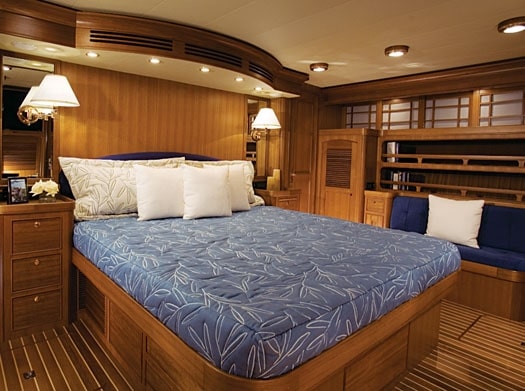
| | |
But it’s not just the guest accommodations that are unusual: the Marlow 86 CMY has crew quarters that rival those on yachts far larger. With access from the salon, there is also a door directly to the side deck for non-intrusive comings and goings of crew. Once on the lower deck, there is a common crew area with a settee and TV plus a galley with fridge and microwave. The captain gets a cabin with a double berth, desk, and sink, plus there’s a full suite of navigation instruments in the forward bulkhead so he can keep an eye on things at all times.
Two additional private cabins are arranged with singles in each, and there are shared but separate shower and toilet compartments. The crew quarters are also finished to the same standards as the rest of the yacht, with teak paneling and superb joinery.
Standard on the 86 CMY is a flying bridge, with the helm and entertainment settees under a fiberglass hardtop-that leaves an immense boat deck for carrying a large tender plus an assortment of watertoys. But I can also see that the 86 would be well-suited to a fully enclosed skylounge: it wouldn’t have a negative impact on the profile nor would it compromise the boat deck space.
There are far too many details about the Marlow 86 to cover them all-from the thoughtful wiring runs that allow full accessibility, to little touches like handrails placed along the overheads. I particularly liked the fold-out helm controls built into the Portuguese bridge wings. Not only do they position the pilot perfectly for docking or anchoring, but they’re also pleasant spots from which to skipper in the fresh air.
Each new Marlow raises the bar on design, construction, and finish, and the 86 CMY once again delighted and pleased me with many thoughtful touches, a clever layout, and her seamanlike qualities.
The surprises on this boat are all good ones.
Marlow Yachts, (800) 362-2657; www.marlowyachts.com




